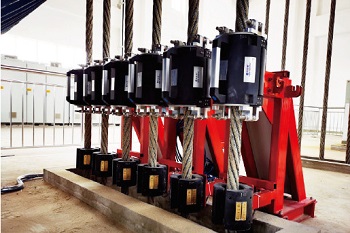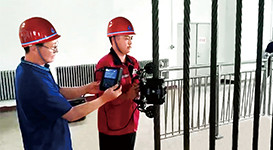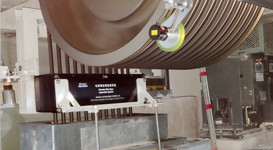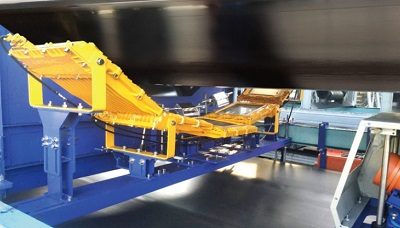
|

|

|

|
abstract:This article analyzes in detail the difficulties in detecting steel wire ropes in mine hoisting systems and the reasons why steel wire ropes are often broken due to external forces, resulting in major accidents such as rope breaks and car slips. It discusses the application of the TCK.W steel wire rope online automatic monitoring system from four aspects: working principle, system function, system characteristics, and system operation, and explains the significance of nondestructive testing of steel wire ropes for mine hoisting safety.
1cause analysis
With the continuous improvement and advancement of production technology and social concepts, more and more attention has been paid to safety production. The mechanical and electrical safety protection of mine hoisting systems has also become increasingly perfect. However, due to operational errors, mechanical failures in the braking system, electrical and circuit issues, the steel wire rope in the mine hoisting system is often broken due to external forces during operation, resulting in serious and catastrophic accidents such as rope breaks, car slips, and bottle jams. This also brings significant losses in terms of economy and personal injuries.

During the operation of the mine hoisting system, understanding the phenomenon of steel wire rope breakage, rusting, and corrosion is of great significance for the safe operation of the hoist. Typically, we use visual inspection and vernier calipers to judge the trend
(1) Using visual inspection, it is only possible to observe the surface trend of the steel wire rope, and it is impossible to see the internal broken wire situation.
(2) Measuring the steel wire rope with vernier calipers can only measure the change of broken wires and broken strands section by section, and it is impossible to measure the entire rope.
Therefore, based on this situation, it is necessary to develop a system that can comprehensively and automatically detect the operation status of the steel wire rope, including broken wires, rusting, corrosion, and other situations throughout the entire rope.
2 TCK.W Wire rope online automatic monitoring system
The TCK.W steel wire rope online automatic monitoring system uses weak magnetic detection technology to detect the residual magnetic signal on the steel wire rope by utilizing the spatial magnetic field vector potential change and operation law. This enables online detection and precise positioning of various damage and change conditions such as steel wire rope breakage, rusting, fatigue wear, etc. Finally, a text report is printed. This monitoring system can be widely used on steel wire ropes of mine hoisting machines, port handling machinery, and construction, tourism and other industries' lifting and transportation machinery.
2.1 Working principle
Based on the on-site investigation, the detection device is installed at the top of the auxiliary shaft's tower, and after installation, it is firmly and reliably fixed. The steel wire rope can pass through the detection device flexibly. The detection system consists of a detection device, a detection work secondary station, and a main control station. It uses weak magnetic detection technology to detect the residual magnetic signal on the steel wire rope by utilizing the change and operation law of the spatial magnetic field vector potential. The device is connected to the secondary station through a data line, and the secondary station is connected to the main control station through a communication line, data line, and power line. Open the detection probe, put the steel wire rope at the center position of the detection probe, and then loosen the detection probe. The detection device moves synchronously with the steel wire rope's operation. During detection, through the detection probe's detection of the steel wire rope's metal effective section area, the secondary station achieves analog-to-digital conversion. Finally, the detected information is transmitted to the main control station, and then after comprehensive analysis of the detected information, the main control station generates a monitoring report on steel wire rope breakage, rusting, wear and other injuries.
2.2 system function
(1) The detection device uses dedicated sensors to accurately detect steel wire rope breaks, rust, fatigue and other injuries.
(2) The secondary station uses an ARM microcontroller and a 12-bit precision A/D sampling chip to achieve high-precision analog-to-digital conversion.
(3) The main control station is the nerve center of the entire monitoring system. It can conduct comprehensive analysis of the detection information, provide daily analysis and processing results, and trends of steel wire rope damage changes, and achieve online real-time monitoring.
2.3 System Characteristics
(1) It has achieved full-rope online real-time monitoring without the need to stop the production line, and it does not affect the operation of other equipment or impact the surrounding environment.
(2) The monitoring device uses sensors that accurately detect steel wire rope breaks, rust, and fatigue to ensure safety and operation.
(3) It has a working environment temperature range of -20℃ to +40℃.
(4) Based on daily monitoring, it can predict trends in steel wire rope breakage, corrosion, and rust. This allows for early identification of potential issues and ensures safe operation.
(5) It features an optimized user interface, ease of operation, sleek appearance, and innovative structural design that reflect modern industrial product efficiency and simplicity.
(6) It solves a series of challenges related to steel wire rope handling on follow-up winding hoists, including rope alignment and significant rope movement.
2.4 system
(1) Double-click the computer desktop icon to run the "TCK.W Steel Wire Rope Online Real-time Safety Detection and Management System", enter the system main interface, which is composed of four parts: the title area, curve display area, scrolling information bar, and function button area. The main function is to display the steel wire rope injury curve in real-time and achieve functions such as establishing a steel wire rope target file, system calibration, detection, stop, viewing the steel wire rope injury curve and injury data through the function buttons.
(2) Log in to the system. Enter the corresponding password to protect the information security and prevent accidental operation by non-operators.
(3) Set the current target. Setting the target is to group related data together to obtain accurate analysis results.
(4) Return to the system main interface, click the "Detect" button, and the system starts detecting the steel wire rope; click the "Stop" button, and the system stops detecting and automatically saves the collected data. During the detection process, the curve display area of the system main interface displays the detected injury curve in real-time.
(5) View the results. In "Results", we can clearly view the injury curve and daily record value, and print them.
(6) View data. In "Data", we can clearly see various injury data results.
3 application prospect
Our group's Meiyukou Mine, Yanzi Mountain Mine, Madigang Mine, and other mines have installed and used the TCK.W steel wire rope online automatic monitoring device, and so far, the operation is normal. It monitors the entire steel wire rope in real-time with high precision, effectively ensuring the normal and safe operation of the hoist and ensuring the safety of coal mine production. It has a broad market promotion prospects.
Received: 2011-03-24
Author: Du Xiaoqin (1974-), female, from Datong, Shanxi, Engineer, researching the maintenance and renovation of large-scale equipment in coal mines.
Technical exchange email: mailto:wm@wmndt.com
The application of TCK.W wire rope detection technology in academic journals
Editor's note: TCK.W has developed a weak magnetic rope detection technology that can real-time monitor the status of steel ropes 24 hours a day, 365 days a year, and locate, classify, and quantitatively identify various internal and external defects. Currently, more than 2,500 clients in 42 countries worldwide are using this technology. These clients have published papers on the safety and economic benefits brought about by this new technology in various academic journals. Here is a compilation of some of these papers for experts and scholars to explore and study in depth.。
论文名称
作者单位

 publish:《Mechanical and Electrical》
publish:《Mechanical and Electrical》